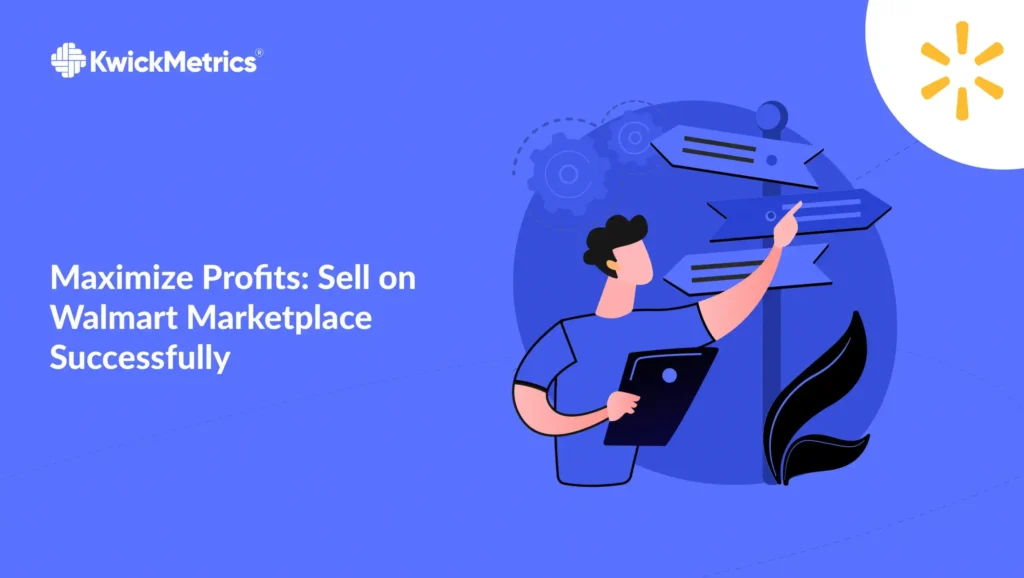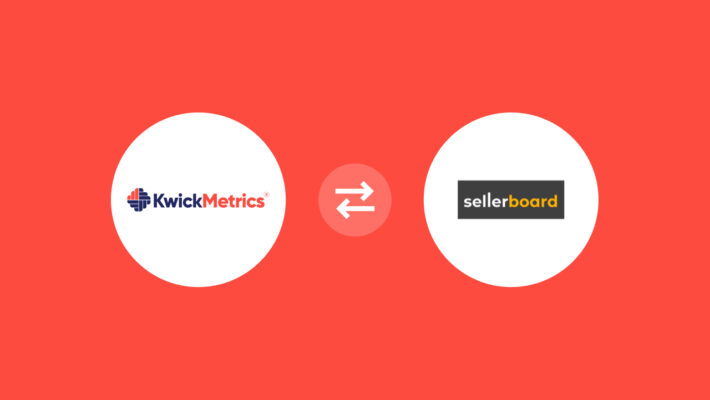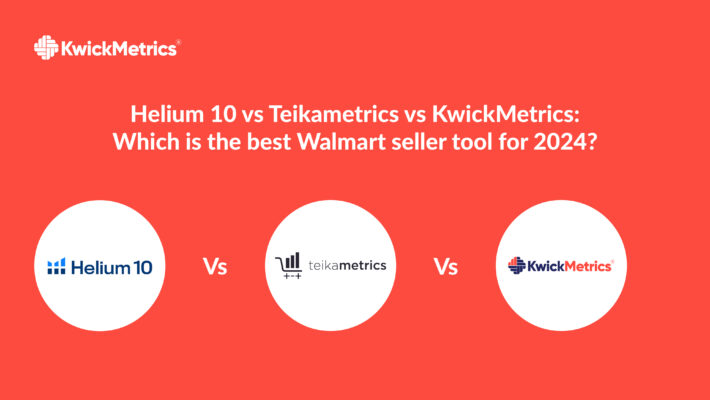Maximize Profits: Sell on Walmart Marketplace Successfully

Table of Contents
- What Is Walmart Marketplace?
- Boost Your Sales With KwickMetrics
- How Does Walmart Marketplace Work?
- Walmart Suppliers vs. Walmart Marketplace Sellers: What’s the Difference?
- Try Our KwickMetrics - One Tool with Multiple Solutions!
- Walmart Suppliers vs Walmart Marketplace Sellers
- How Large Is the Walmart Marketplace?
- How to sell on Walmart Marketplace?
- Qualifications for Individual Sellers
- KwickMetrics: Elevating Walmart Ventures
- Explore Our Features!
- Why Choose KwickMetrics for Your Walmart Venture?
- FAQs in Relation to Sell on Walmart Marketplace
- Conclusion
The e-commerce landscape is vast and continually evolving, with one of its prominent players being the Walmart Marketplace. Explore opportunities to sell on Walmart Marketplace for success in online retail.
In this comprehensive guide, we’ll navigate through the intricate details of the Walmart Marketplace, providing insights into what it is, how it operates, and the distinctions between Walmart Suppliers and Marketplace Sellers.
We’ll also delve into the expansive scale of the Walmart Marketplace and shed light on the eligibility criteria for individual sellers. Let’s embark on a journey to gain a deeper understanding and mastery of the sell on Walmart Marketplace.
What Is Walmart Marketplace?
Walmart Marketplace is an expansive digital platform that acts as a bridge for third-party sellers to showcase and sell their products alongside the offerings presented by Walmart itself. Essentially, it serves as a massive online marketplace where a diverse range of products becomes available to customers through various sellers.
The primary purpose of Walmart Marketplace is to create a digital space where sellers, ranging from individuals to businesses, can connect with millions of potential customers. It transforms the traditional retail model into an extensive and accessible online shopping destination.
Boost Your Sales With KwickMetrics
Explore 14-day free trial! No credit card required, cancel at any time.
How Does Walmart Marketplace Work?
Onboarding Process
Joining Walmart Marketplace involves a detailed onboarding process. Sellers need to undergo registration on the platform, meeting specific and rigorous standards set by Walmart. This includes the creation of accurate and comprehensive product listings. Importantly, sellers take on the responsibility for the entire order fulfilment process, covering tasks from shipping to customer service.
Key Features and Strategies
Walmart Marketplace introduces unique features to enhance the selling experience. Two-day Delivery is one such feature, aiming to provide quick and efficient shipping. The Walmart Buy Box, another crucial element, significantly influences a product’s visibility and sales. Sellers aiming for sustained success must continuously optimize their product listings and adhere to Walmart’s fee structure.
In essence, Walmart Marketplace operates as a facilitator, connecting sellers with a vast customer base and providing shoppers with an extensive array of products to choose from. The success of sellers on this platform depends on their ability to navigate its features, meet stringent standards, and strategically position their products for optimal visibility and sales.
Key Takeaway:
Think of the Walmart Marketplace as your virtual storefront, a buzzing hub with millions of potential customers. With Walmart's commitment to e-commerce expansion and enhanced seller support, it's prime real estate for online merchants. But remember, success here demands an understanding of its tools, policies and customer service expectations.
Walmart Suppliers vs. Walmart Marketplace Sellers: What’s the Difference?
Walmart Sellers
Individuals or businesses operating within the Walmart Marketplace fall under the category of Walmart Sellers. They manage their digital storefronts, product listings, pricing, inventory, and customer service. The direct responsibility for shipping products to customers lies with Walmart Sellers.
Walmart Suppliers
Walmart Suppliers, in contrast, are entities that directly provide products or services to Walmart for resale in its physical stores or online platforms. The process involves a through approval process, negotiation of pricing and contract terms, and ensuring a consistent supply of products to Walmart’s various outlets.
Distinctions in the Supply Chain
The primary distinction lies in their roles within the supply chain. While Walmart Sellers focus on direct consumer sales through the Marketplace, Walmart Suppliers collaborate closely with Walmart to provide products for resale in Walmart’s retail outlets.
Try Our KwickMetrics - One Tool with Multiple Solutions!
Walmart Suppliers vs Walmart Marketplace Sellers
| Aspect | Walmart Suppliers | Walmart Marketplace Sellers |
|---|---|---|
| Role | Provide products or services directly to Walmart for resale. | Operate within the Walmart Marketplace, managing digital storefronts and customer interactions. |
| Approval Process | Rigorous approval process involving negotiation of pricing and contract terms. | Relatively straightforward sign-up and onboarding process. |
| Product Listings and Inventory | Managed by Walmart in collaboration with the supplier. | Managed independently by sellers who control their own product listings and inventory. |
| Pricing Control | Negotiated with Walmart and typically at wholesale prices. | Controlled by the seller who determines their own pricing strategy. |
| Shipping Responsibility | Handled by Walmart; the supplier is not responsible for shipping to end customers. | Managed by sellers, either independently or with assistance from third-party services. |
| Customer Service | Typically, Walmart manages customer service related to products supplied. | Sellers are responsible for their own customer service and support. |
| Sales Channel | Products sold in Walmart's physical stores and online platforms. | Products listed and sold on the Walmart Marketplace website. |
| Supply Consistency | Suppliers ensure a consistent supply of products to Walmart's various outlets. | Sellers manage their own inventory and supply chain. |
Key Takeaway:
When selling on Walmart, you can be a supplier or a marketplace seller. As a supplier, you sell products directly to Walmart at wholesale prices and they handle shipping. But as a marketplace seller, you list your products on walmart.com, control pricing and fulfill orders yourself or with help from services like FedEx's Smart Post.
How Large Is the Walmart Marketplace?
The Walmart Marketplace has experienced phenomenal growth, currently boasting over 150,000 sellers contributing to its diverse ecosystem. This number is anticipated to rise as Walmart continues to expand its e-commerce operations, attracting a growing number of third-party sellers to the platform.
If you’re planning to sell on the Walmart Marketplace, there are certain qualifications that you need to meet. Walmart uses these criteria as a way to guarantee that their customers receive excellent goods from dependable merchants.
How to sell on Walmart Marketplace?

Qualifications for Individual Sellers

Individuals aspiring to sell on the Walmart Marketplace must meet specific criteria. This includes possessing a valid Business Tax ID or Business License Number and providing supporting documents that verify their Business Name and Address.
Key Takeaway:
To sell on Walmart Marketplace, you need to meet key qualifications. Proving a successful online selling history with documents like your business tax ID can boost approval chances. Also, navigating the rigorous verification process successfully - which includes submitting necessary documentation and ensuring transparency in communication - is crucial.
Demonstrating eCommerce Success
A crucial aspect is demonstrating a history of success in the marketplace or Walmart eCommerce growth. This can significantly influence the approval process and enhance the chances of becoming a Walmart Marketplace seller.
Product Criteria and Compliance
Products to be listed on the Walmart Marketplace should have GTIN or UPC numbers with a GS1 Company Prefix. Additionally, the product catalog must comply with Walmart’s Prohibited Products Policy.
Fulfilment Options
Individual sellers have the flexibility to fulfil orders through Walmart fulfilment Services (WFS) or another US-based Business-to-Consumer (B2C) warehouse. Meeting these requirements and providing necessary documentation are vital steps in gaining approval as an individual seller on the Walmart Marketplace.
Key Takeaway:
Get your products ready for Walmart Marketplace: To list on this platform, each product needs a unique identifier like a GTIN or UPC number with a GS1 Company Prefix. This isn't just paperwork—it's an industry standard that ensures your items stand out.
KwickMetrics: Elevating Walmart Ventures
Empower your Walmart venture with KwickMetrics, where data transforms into profit and success is a measurable reality. How does KwickMetrics assist Walmart sellers?
-
- All-In-One Sales Dashboard: Stay on top of your financials with a comprehensive sales overview.
-
- Detailed Product List: Access a detailed list of your products for efficient management.
-
- Product Category Tree: Navigate and optimize your product categories effortlessly.
-
- Efficient Expense Management: Streamline expenses to maximize profitability.
-
- Built-In Reports: Gain actionable insights with KwickMetrics’ built-in reporting features.
- Built-In Reports: Gain actionable insights with KwickMetrics’ built-in reporting features.
Explore Our Features!
Why Choose KwickMetrics for Your Walmart Venture?
In the dynamic landscape of e-commerce, KwickMetrics stands out for its ability to turn data into profitable outcomes. Elevate your Walmart venture with:
- Real-Time Insights: Stay informed with up-to-the-minute data, enabling quick and informed decision-making.
- Precision in Selling: Master the art of selling on Walmart Marketplace with precision, leveraging insights derived from KwickMetrics.
- Strategic Growth: Plan your growth strategy based on accurate data, ensuring every move is backed by insights that drive success.
FAQs in Relation to Sell on Walmart Marketplace
How much does it cost to sell on Walmart Marketplace?
Selling on Walmart Marketplace is free. However, they do charge a referral fee ranging from 6% to 20%, depending on the product category.
Is selling on Walmart Marketplace worth it?
Absolutely. With over 120 million monthly visitors, you get immense exposure for your products which can translate into higher sales.
Can individuals sell on Walmart Marketplace?
No, only businesses with a valid tax ID or business license number are allowed to sell their goods through the marketplace.
Is it hard to get approved to sell on Walmart Marketplace?
The approval process may be stringent due its quality control standards but having a successful track record and solid business credentials increases your chances of getting approved.
Conclusion
The Walmart Marketplace emerges as a dynamic hub for e-commerce growth, connecting sellers with a vast consumer base. Explore strategies to thrive when you sell on Walmart Marketplace.
This guide has provided foundational insights into its workings, the distinctions between suppliers and sellers, and the qualifications for individual participation.
As we delve deeper into subsequent sections, sellers can anticipate a wealth of strategies and tips for optimizing their presence.
The expansive scale of the marketplace underscores its significance, making it a compelling avenue for both seasoned sellers and newcomers seeking to thrive in the ever-evolving world of digital retail.




